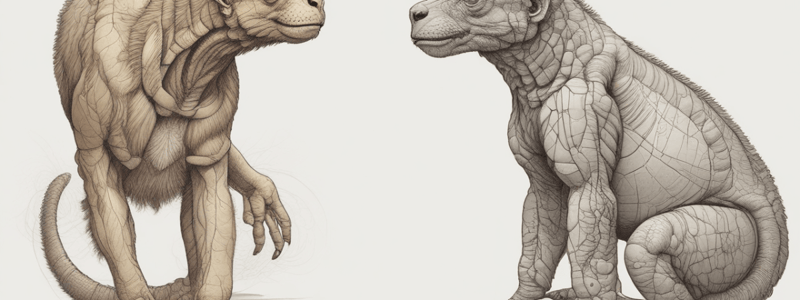Podcast
Questions and Answers
What is the primary mechanism by which organisms adapt to their environment?
What is the primary mechanism by which organisms adapt to their environment?
- Genetic mutations
- Gene flow
- Random genetic drift
- Natural selection (correct)
What is the result of natural selection over time?
What is the result of natural selection over time?
- Environmental destruction
- Evolution (correct)
- Genetic variation
- Species extinction
What is the main reason for the population shift towards darker-colored moths in the Industrial Revolution?
What is the main reason for the population shift towards darker-colored moths in the Industrial Revolution?
- Food scarcity
- Predator preference
- Genetic mutations
- Environmental pollution (correct)
What is the key factor that determines the survival and reproduction of finches in the Galápagos Islands?
What is the key factor that determines the survival and reproduction of finches in the Galápagos Islands?
What is the primary source of variation in traits within a population?
What is the primary source of variation in traits within a population?
What is the term for the change in the inherited characteristics of populations over successive generations?
What is the term for the change in the inherited characteristics of populations over successive generations?
What is the primary function of carbohydrates in cellular processes?
What is the primary function of carbohydrates in cellular processes?
What determines the atomic number of an element?
What determines the atomic number of an element?
What is the result of natural selection over time?
What is the result of natural selection over time?
What is the primary function of lipids in cellular processes?
What is the primary function of lipids in cellular processes?
What is the role of neutrons in an atom?
What is the role of neutrons in an atom?
What is the term for the struggle for existence among individuals in a population?
What is the term for the struggle for existence among individuals in a population?
Flashcards are hidden until you start studying
Study Notes
Natural Selection and Evolution
- Natural selection is the process by which organisms with traits better suited to their environment tend to survive and reproduce more successfully than those with less favorable traits.
- Over time, natural selection can lead to changes in the characteristics of populations, known as evolution.
- Evolution occurs as a result of natural selection, genetic drift, gene flow, and mutations.
Examples from Nature
- Peppered Moths: During the Industrial Revolution, pollution darkened tree bark, making lighter-colored moths more visible to predators, resulting in a population shift towards darker-colored moths over time.
- Darwin's Finches: Darwin observed finches in the Galápagos Islands and noted variations in beak size and shape, which were adapted to the available food sources on different islands, increasing their chances of survival and reproduction.
Darwin's Theory of Evolution by Natural Selection
- Variation: Individuals within a population exhibit variation in traits, such as size, color, or behavior, influenced by genetic differences and environmental factors.
- Heritability: Some of the variation observed among individuals is heritable, meaning it can be passed down from one generation to the next through genes.
- Struggle for Existence: Populations produce more offspring than the environment can support, leading to competition for limited resources.
- Differential Survival and Reproduction: Individuals with traits that provide an advantage in their environment are more likely to survive and reproduce, passing on their advantageous traits to their offspring.
- Natural Selection: Over time, traits that confer advantages become more common in the population, while less advantageous traits become less common, leading to evolutionary change.
Atoms
- Atomic Structure: Atoms are the basic building blocks of matter, consisting of a nucleus surrounded by electrons, with protons and neutrons in the nucleus and electrons orbiting in electron shells or energy levels.
- The number of protons in the nucleus determines the element's identity, while the number of neutrons can vary, resulting in different isotopes of the same element.
Subatomic Particles
- Protons: Positively charged particles found in the nucleus, determining the atomic number of an element, which defines its chemical properties, with a relative mass of approximately 1 atomic mass unit (amu).
- Neutrons: Neutral particles found in the nucleus, adding to the mass of the atom without affecting its charge.
- Electrons: Negatively charged particles that orbit the nucleus in specific energy levels or electron shells, determining the atom's size and reactivity, with a negligible mass compared to protons and neutrons.
Macromolecules
-
Carbohydrates: Main source of energy for cellular processes, providing structural support in cell walls (e.g., cellulose in plants) and exoskeletons (e.g., chitin in arthropods), with examples including glucose, starch, and cellulose.
- Monomers: Monosaccharides (e.g., glucose, fructose).
- Polymers: Polysaccharides (e.g., starch, glycogen, cellulose).
-
Lipids: Long-term energy storage, structural component of cell membranes, and insulation and protection of organs, with examples including fats, oils, phospholipids, and steroids.
- Monomers: Fatty acids and glycerol.
- Polymers: Triglycerides, phospholipids.
Studying That Suits You
Use AI to generate personalized quizzes and flashcards to suit your learning preferences.




